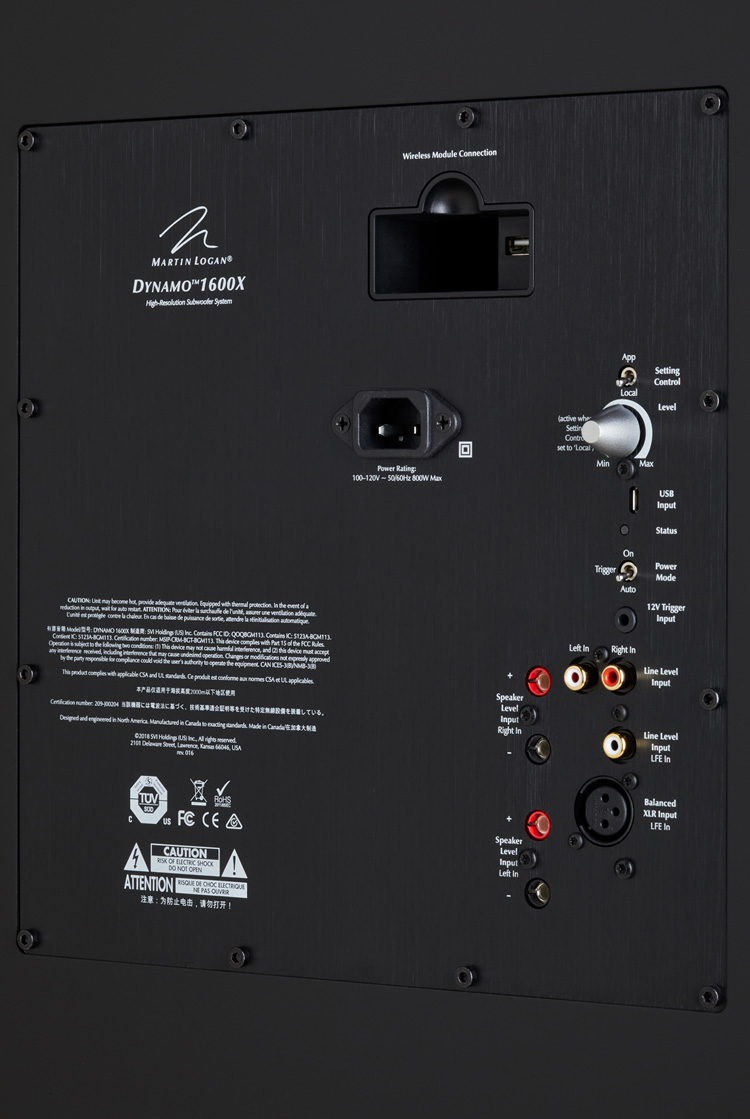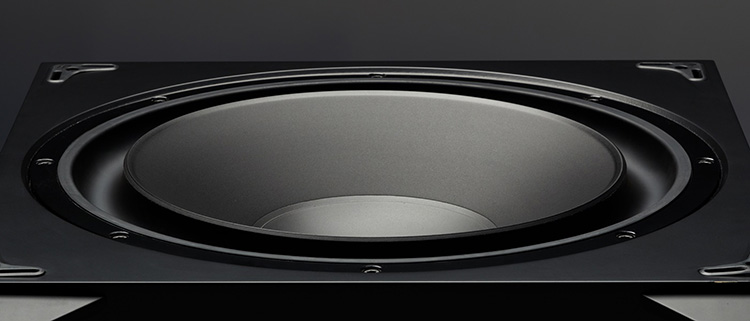
I mean this bad ass little sub can really put out some clean and tight low bass. That was my first impression, but over time I came to appreciate this subwoofer’s greater charms – its supple and agile response that really set it apart from competing subwoofers.
MartinLogan Dynamo 1600X Powered Subwoofer
- Built-in Anthem Room Correction (ARC)
- Excellent calibration and control apps
- Impressive low bass extension
- Flexible set-up options
- Serious output capability with inaudible distortion levels
- Low-cost upgrade paths available
The newly updated MartinLogan Dynamo subwoofer lineup includes five models that are all sealed box designs and range in driver size from 8” up to 15”. Internal power ratings range from 900 watts RMS in the 15” model down to 75 watts RMS in the smallest sub. This review will focus on the largest model, the 15” Dynamo 1600X.
The Dynamo subs incorporate a lot of significant features. I think the biggest of these is the smartphone control as well as a separate app with Anthem Room Correction (ARC) implementable through your smartphone too.
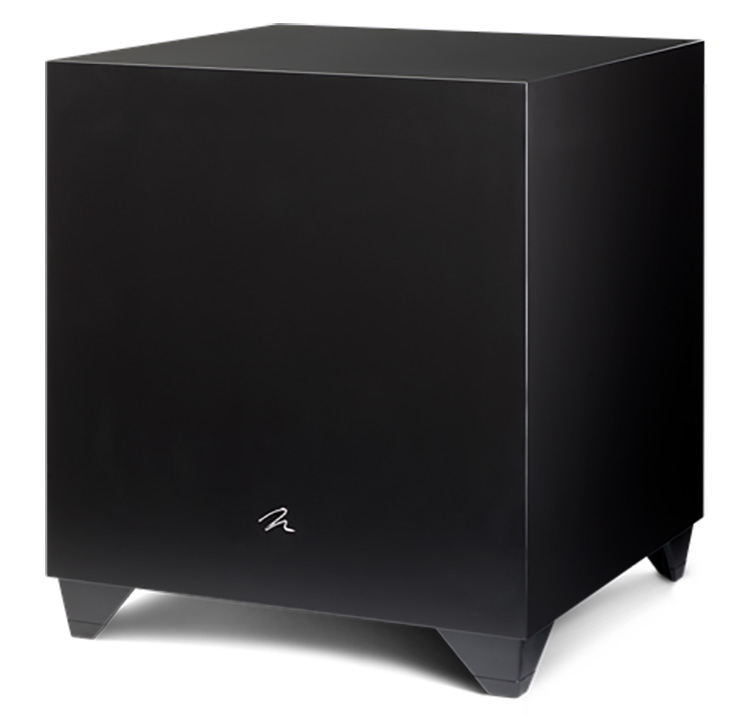
This sub has a great deal of flexibility in its design. It can be connected to your system wirelessly with the optional SWT-X Wireless Subwoofer System ($199.95). The system is easily configurable as either forward-firing or down-firing. Some people may recommend the down-firing configuration for cinema applications while the forward-firing set up is claimed to be better for music playback. MartinLogan does not make this assertion but stated that the optional configurations allow for custom installs as well as customer preference.
This sub has other charms and performance qualities that I will delve into in the below review.
Design:
Sealed Non-Resonant Cabinet
Driver:
15” High-Excursion, Inverted Surround, Polypropylene Cone in a Cast Aluminum Basket with Extended Throw Driver Assembly
Inputs:
Line Level: Left, Right, and LFE
Speaker Level: Left and Right Via Banana Plugs
XLR: LFE
Wireless: SWT-X Receiver & Transmitter (Sold Separately)
Internal Amplification:
900 Watts (1,800 Peak)
MFR:
20 – 200 Hz (+/- 3dB) (LFE Mode)
Input Impedance:
RCA: 8,300 Ohms
Speaker Level: 2,000 Ohms (red to black)
XLR: 28,000 Ohms (pin 2 to 3)
Controls (Via App/Bluetooth):
Level: -40 to 12dB
Low-Pass Filter (Frequency): 35 – 120Hz
Low-Pass Filter (Order): Bypass, Third, Fourth
Phase: 0 – 180° (1° Increments)
Phase (Polarity): Normal, Inverted
Preset Listening Modes: Music, Night, Movie
20 – 30Hz Level: ±10dB
Anthem Room Correction (ARC): On, Off
Tone Sweep (20–120Hz): On, Off, Pause (Frequency)
Control Apps:
Sub Control App: iOS and Android
Anthem Room Correction: iOS, Android, and PC
Room Correction:
Anthem Room Correction (ARC)
Cabinet Dimensions (inches):
Front-firing: 20.1″ H x 17.9″ W x 19.1″ D
Down-firing: 20″ H x 17.9 ” W x 18.5 ” D
Cabinet Weight:
57 lbs
Finish:
Satin Black
MSRP:
$1,699.99 (USD)
Company:
SECRETS Tags:
MartinLogan, Subwoofer, Powered Sub, Dynamo, 15”, ARC, Anthem Room Correction, ARC, Sealed Box, Deep Bass, Low Distortion, Control App, Subwoofer Review 2019
The two most common woofer loading schemes are bass reflex (ported or passive radiator) and acoustic suspension (sealed). Ported designs are probably the most common. Ported woofers tend to have slightly deeper bass extension with a faster roll off. All things being equal, they are more sensitive but also have larger enclosures. Sealed designs can be more compact and have less extension but with a gentler roll-off.
I have a fondness and affinity for sealed box subwoofer designs. I like the tighter bass response and gentle roll-off. In the distant past, sealed subs were even less common than today because they really needed drivers with strong magnet structures along with powerful amplification in order to keep pace with ported designs which were much more commonplace a few years back.
MartinLogan engineers are familiar with these requirements and recognize that nowadays these issues can be readily overcome with competent design and manufacturing practices. As a result, the Dynamo series of subs have very well designed woofers with high excursion along with large and powerful motor structures. They are then driven by very powerful amplifiers. In the case of the Dynamo 1600X, the amp is rated at 1,800 watts peak output!

The high-excursion drivers are equipped with inverted surrounds which testing has indicated reduces turbulence issues, thereby lowering the distortion in the room.
The plate amps on these subs provide a bunch of interesting hook up options. You can hook up a mono LFE channel, balanced or unbalanced. This is good for movies in a surround application. For music-centric systems, you can connect the woofer to either the high or low level (unbalanced) stereo inputs. You can also connect LFE and stereo at the same time which, in MartinLogan’s own words, “allows simultaneous connection of both 2-channel stereo music and multichannel home theater and allows each source to have individual crossover and level settings. LFE inputs use no low-pass filter, leaving crossover control to the processor. Left and right inputs integrate discrete user-adjustable low-pass filters allowing different level and crossover points when playing back two channel music”. This is brilliant.
Don’t forget that the MartinLogan Dynamo 1600X has a wireless adapter that one can get for a nominal additional price (less than $200). If I were building a new system, I would definitely consider a wireless hook up. It is actually the economical option in lieu of running a ton of expensive cables all over the place.
The other design element of the Dynamo 1600X is that it can be configured for down-firing or front-firing options. I love this. The unit comes with a cloth grille that is not used for down-firing but can be fitted when you set it up for a forward-firing arrangement. When you make the switch, you move the feet to the back of the enclosure and what was the front becomes the top, placing the MartinLogan logo on top. This puts the plate amp on the bottom which isn’t a massive concern because you don’t need to access these controls once positioned as you can use the MartinLogan Subwoofer Control App to adjust every setting that is available to the user and never really need to access the controls on the amp ever after.
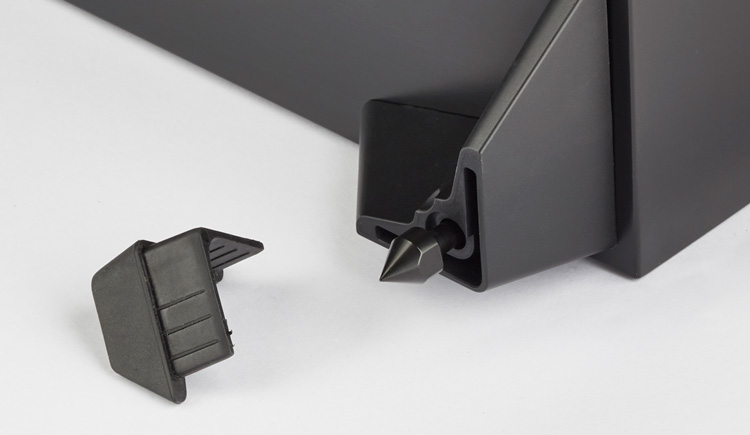
MartinLogan also incorporated another brilliant feature in this sub. There are built-in spikes that can be exposed by sliding off the rubber feet. This is a quick and easy way to couple the sub to your floor!
This sub comes with wireless control that also works with the ARC Mobile App to apply room correction to the sub. This app uses the mic on your smartphone to measure the subwoofer via the highly regarded ARC room correction process. As mentioned previously, you could also opt for the $100 Perfect Bass Kit which includes a calibrated mic and tripod. This will give more precise results in term of room correction. I found that the ARC app on my iPhone X did an admirable job and it comes included. So I rolled with that for this review.

Once installed and calibrated, the sub can be controlled by another wireless app called the MartinLogan Sub Control App which allows the user to control volume level, low-pass filter (frequency and order), phase, 20 – 30Hz level, three preset listening modes, and control of Anthem Room Correction. It can also issue a tone sweep that is used to locate rattles in your listening room.
I set up the Dynamo 1600X in the front left corner of the room which is the typical location for a sub in my theater. It is very unfortunate that this corner placement is hamstrung by a significant suckout at around 45 Hz when tested at the prime listening position. But the fact of the matter is that the room’s overall configuration (along with WAF considerations) obviate any other reasonable placement options.
The good news here is that the Dynamo 1600X subwoofer has a superpower. That superpower is Anthem Room Correction (ARC) via a smartphone app. The sub is also compatible with the full ARC system (known as the Perfect Bass Kit) that includes a calibrated mic and software for a computer. This full PBK system is an excellent upgrade path for an additional $100.00 investment. The Dynamo 1600X is also forward-compatible with ARC Genesis software which will be launched later in 2019.
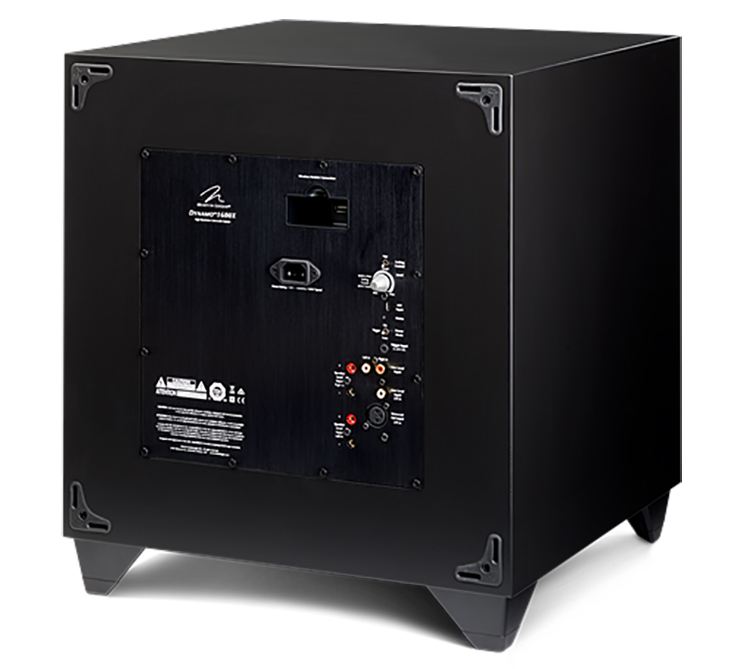
I personally used the included ARC iPhone app on my iPhone X. I ran the ARC system first and then followed that up with the full Dirac Live calibration using my surround processor with a connected laptop for all the processing and upload. ARC by itself reduced the suckout by over 6 dB which is quite excellent. The suckout was still measurable but the improvement was significant.
In terms of placement, aside from the fact the Dynamo 1600X was placed in the corner, I set it up in its default down-firing configuration. The sub looks cleaner this way (no visible grille). I did try the front-firing set up as part of the review. I didn’t notice a significant change in the bass, but my intuition leads me to believe this would be the better set up for music listening.
Now that I had the MartinLogan Dynamo 1600X set up and calibrated, it was time for some movies and music!
I auditioned this subwoofer over a three-month period of time. In that time, I estimate 75% of the critical listening was cinema and the other 25% was music listening. The Dynamo 1600X impressed me right out of the gate with its forceful low bass output. It didn’t quite have the extension I have gotten with other subs, but it did put out apparent low bass down to 20 Hz.
So it didn’t deliver super low bass below 20 Hz but what it did produce was so dynamically unrestrained, nobody would know the difference outside of a direct comparison. What I was hearing was certainly pleasing to me and I could easily live with this sub for the rest of my natural days.

The MartinLogan Dynamo 1600X sub stood out on a number of the movies I watched. One of these was “First Man”. This is the story of Neil Armstrong, the first man to walk on the moon. It is different from most space-themed movies. Most of these movies tend to be third person narrative with lots of theatrics. “First Man” on the other hand was told more from a first person point of view. So many of its “action” scenes were nearly claustrophobic with long sequences inside the spaceship. These scenes featured constant low bass energy and this made for some excellent demo material in the subwoofer department.
What I heard in these scenes was a sub that was indefatigable, pumping out the sustained low bass effects with nary a hint of stress or strain. It kept pace with all the other effects and voices. The integration and blend I was getting was as good as any subwoofer I have reviewed in the last two years.

I also want to make note of a real blow yer doors off kind of movie – “Mission Impossible Fallout”. I didn’t go for the cinematography this time around. It was too contrived in an effort to make it artsy. But being that it is a Tom Cruise movie, the audio side of things was off the charts good.
The Dynamo 1600X pounded out bass effects like nobody’s business. This movie has large-scale action scenes that work best when your sub can crank out low bass tones on command. There were so many great moments for the Dynamo 1600X in this movie that it is hard to pick just one to mention but if I have to pick one, it would be the helicopter chase scene. This is top demo material and the Dynamo 1600X really brought out the best in my system from take-off to crash landing to the struggle on the cliff.
This movie had other sequences where the bass got so loud, it made me uneasy and my conscious brain told me to turn down the sub but I let it ride and the Dyanamo sub never blinked. The sofa felt like it would cave in first. It truly amazed me to be honest.

There was another fun movie in the repertoire that bridged the gap between action and music – “Ocean’s 8”. What I mean is that this movie doesn’t have much in the way of bombast but the musical score includes a lot of acoustic bass. I very much like the music in all the ‘Oceans’ movies and having this music well-reproduced heightens the experience of enjoying these films.
When subs get this wrong, they may be one-note. Or they may have the ability to delineate the different tones but the response is so peaky that it throws off your perception of the tonality.
The MartinLogan Dynamo 1600X suffered none of these ailments. The bass was appropriately ripe, in tune, and well integrated into the whole. A sealed box sub like this one keeps the bass line bubbling along in time with the music. This quality of rhythmic accuracy is extremely important in this type of demo. It really got my toe tapping.
I did have to play around with the sub level to get it balanced just right on “Ocean’s 8”. This is where the sub app came in very handy. In my system, the only other way I know to remotely adjust the sub level is to go into the on screen menu and adjust it from there. When I do, I get growls, boos and hisses from the audience. With the sub app, I could raise and lower the sub at will and nobody really notices. I didn’t use much of the app’s adjustments, mostly just the level control. Nevertheless, it is handy and most welcome.

On a pure musical note, I want to talk about LCD Soundsystem’s “Electric Lady Sessions”. This album has a lot of dub step bass, electric bass, synthesizer, etc. I enjoyed it immensely over the Dynamo 1600X. Again, the bass was full, extended, tuneful, and integrated. Some of the more noteworthy songs were “american dream”, “get innocuous” (dub step bass and tom toms), “tonite”, and “I Want Your Love” (bass line). Check these out one of these days and you will see what I’m talking about.
I do not have the ability to do ground plane frequency response tests on subwoofers. So I will be relying on MartinLogan to supply frequency response graphs of the 1600X’s performance in a close-mic test. The smoothed close-mic response appears below and it corroborates the manufacturer claim of 20 – 200 Hz +/-3 dB.

I did run some pink noise tests in-room with the mic placed at the listening position. Let me provide a short narrative of the results:
I typically cross over between my sub and satellites at 60 Hz – 80 Hz. With ARC engaged, the 1600X was able to improve the response through my room’s primary suckout frequency by about 6 dB. This is a significant improvement. If you ignore the residual suckout, then the Dynamo 1600X’s in-room response measured at the prime seating position from 20 Hz – 80 Hz was +/- 6 dB with ARC engaged. This is excellent performance for an in-room readout in my system.
The sub is apparently tuned to 20 Hz as that was the point where the gentle roll off began (it’s a sealed box design). One point that is very noteworthy – the ARC system was able to eek out usable response up to about 150 Hz which is excellent in my particular set up and definitely helps blend with the satellites even when they are crossed over at 80 Hz.
Below are a series of tests I ran to determine the total harmonic distortion readings of the Dynamo 1600X subwoofer. These tests were run in-room with the mic placed 2 meters from the woofer’s dustcap.
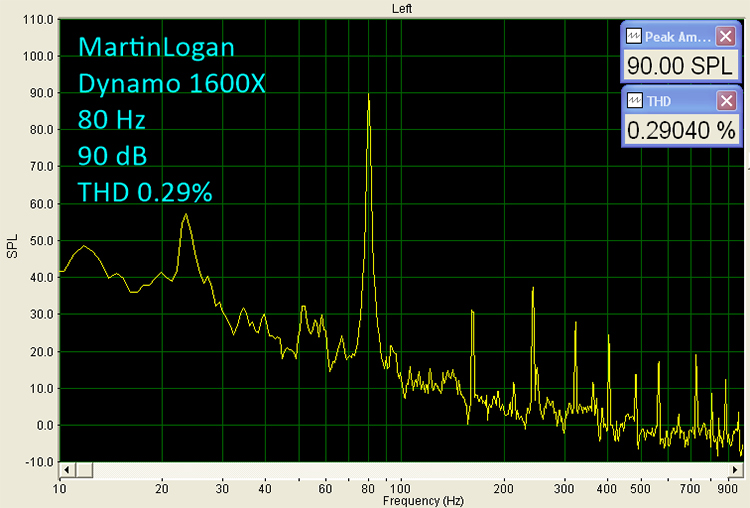
This first graph is a baseline at 80 Hz and 90 dB. The measured distortion was very low at 0.29%.
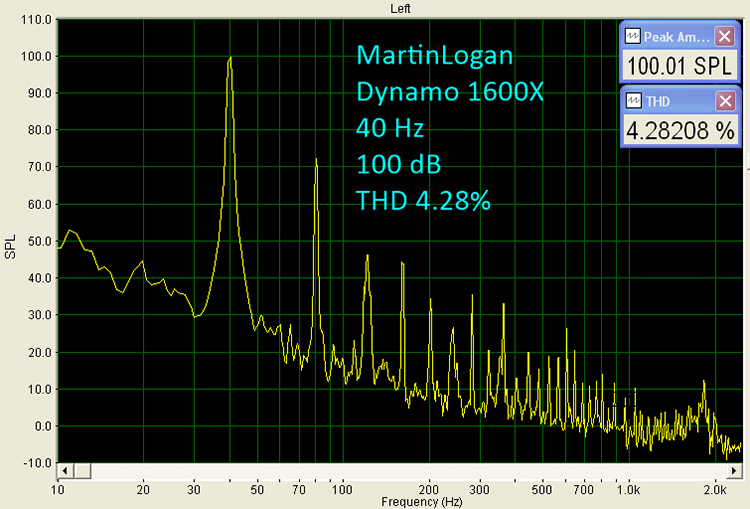
In this second test, I ran a 40 Hz sine wave at 100 dB and the THD was reported back at 4.28%. Let me remind you that this is probably much louder than you may assume and may be louder than I would play my system 99% of the time.
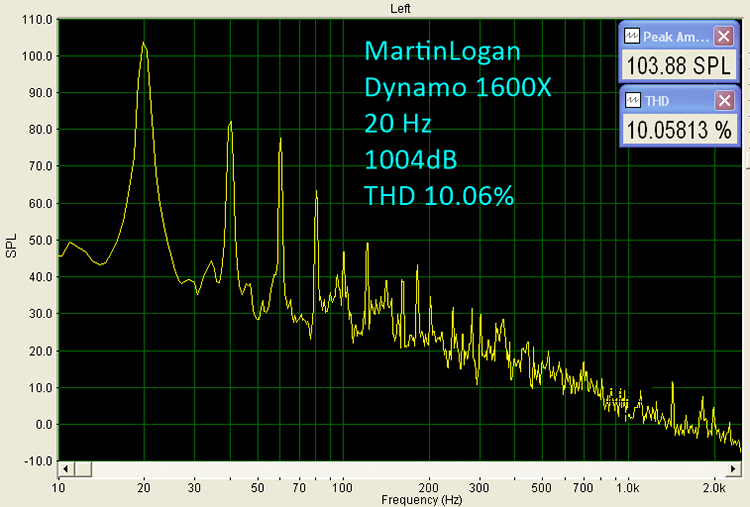
The third distortion graph was done to test the limits of the subwoofer. 10% THD is considered inaudible for low bass. Well, MartinLogan’s sub cranked out close to 104 dB at 20 Hz right at the 10% distortion level. I can tell you that a test like this really shakes you, the room, and everything in it as well as adjacent rooms. I may at times get peaks at this level during regular use but only if I’m trying to show off the system for a friend. Under normal circumstances, the sub never gets called on to do this but rest assured, this woofer could really move some air when needed!

The MARTINLOGAN DYNAMO 1600X SUBWOOFER plays nice on music and then bows up for some rip snorting cinema performance when the time comes.
- Forceful output
- Legit bass extension
- Effortless musicality
- Flexible set up options
- Built-in room correction
- Sub control app
- More finish options
I am going to hate the day I have to pack up this subwoofer and ship it back to MartinLogan. It will be sorely missed when gone. The engineers at MartinLogan have a long history of designing high quality powered and passive subs because their flagship speakers have almost always used subwoofers in one form or another. Now they are relying on all their technology and developmental effort in this latest series of subwoofers. The time, effort, and expertise really shines through.
So what of the MartinLogan Dynamo 1600X subwoofer? My lasting impression will be the eyebrow-raising forceful low bass output. The response I heard in the low bass was fuller than I was expecting and right up there with subwoofers that cost many times more than the Dynamo 1600X. This sub could produce these high levels over sustained periods and never even break a sweat. I mean there really were times I thought the bass would break something in the room but it just kept on keeping on.
As I discussed above, the Dynamo 1600X was able to downshift and blend on music as well as any sub I have reviewed in the last two years. This is where I feel a quality subwoofer really stakes its claim. Musicality is the real trick for a sub and the Dynamo 1600X was ready, willing, and able in this area.
Don’t forget that this is easily one of the most flexible designs I have ever seen. There are a few worthwhile upgrade paths as well which improves the sub’s flexibility score. Being able to get all this for less than $1,700 is just icing on the cake. Great value, great performance, high recommendation!



